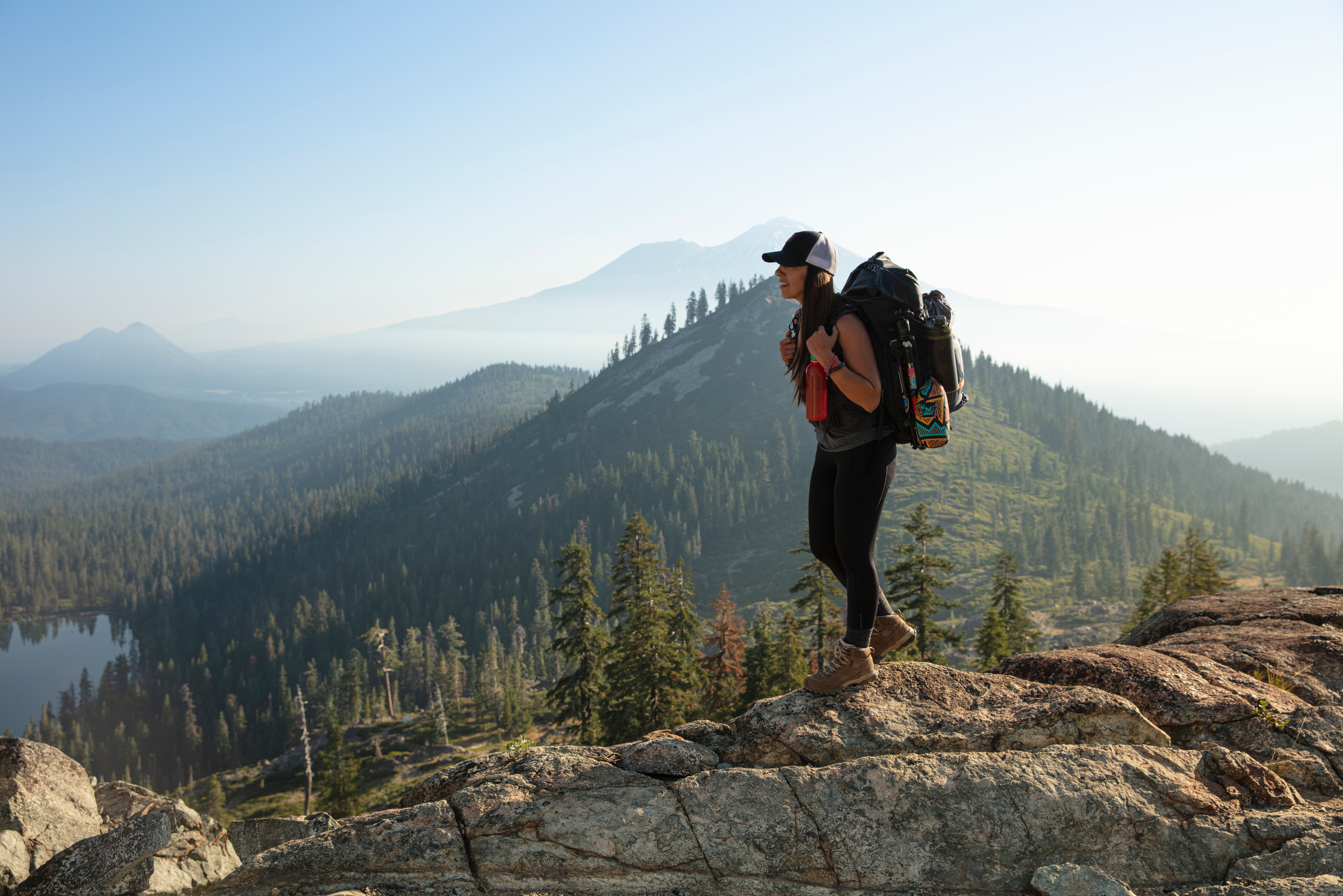Embarking on a hike can raise questions about what gear is needed, especially for women. Women make up more than 45% of hikers in the United States, showing their strong presence on the trails. Our guide dives into essential hiking equipment and safety tips tailored for women, ensuring you’re fully prepared for your outdoor adventures. Get ready to hit the paths with confidence!
Essential Gear for Hiking as a Woman
When it comes to essential gear for hiking as a woman, having appropriate footwear and weather-appropriate clothing is crucial. Additionally, make sure to have a hiking backpack with water, food, first aid kit, navigation tools, safety items, sun protection, and shelter.
Appropriate footwear
Good shoes are a must for hiking. Look for sturdy boots or trail shoes that grip the ground well. Your feet should feel comfy, with no pinching or rubbing. Shoes must be right for the weather too – waterproof ones are best if it’s wet or cold outside.
Choose footwear that supports your ankles on rocky paths. Make sure they have been worn in before a long hike to avoid blisters. Next up, let’s talk about what clothes to wear for different weather conditions while hitting the trails.
Weather-appropriate clothing
Choose clothing made of moisture-wicking and quick-drying materials to stay comfortable during your hike. Look for layers that can be easily added or removed, including a moisture-wicking base layer, an insulating layer, and a waterproof outer layer to protect against wind and rain.
Don’t forget a hat and gloves for added warmth or sun protection as necessary. Also, consider the terrain you’ll be hiking on to choose appropriate footwear with good traction and ankle support, helping you stay safe on the trail.
When choosing clothes for hiking in different weather conditions, prioritize comfort, breathability, and protection from the elements. Proper clothing will keep you dry when it’s wet outside and warm when it’s cold.
This includes wearing moisture-wicking fabrics close to your skin while avoiding cotton since it retains moisture. Additionally, select lightweight yet durable materials that provide UV protection in sunny conditions but are still breathable on hot days.
Hiking backpack
A good hiking backpack for women should be comfortable and fit well. Look for one with padded shoulder straps and a waist belt to distribute the weight. It’s helpful to choose a backpack with multiple compartments so you can organize your gear.
Make sure it’s made of durable, water-resistant material to protect your belongings in case of rain or splashes on the trail.
When choosing a hiking backpack, consider its capacity based on the length of your hikes and whether you plan to carry extra gear like a tent or sleeping bag. Additionally, look for features such as hydration bladder compatibility and easy-to-reach side pockets for water bottles.
A well-fitted and appropriately sized backpack will ensure you have an enjoyable hiking experience without unnecessary strain.
Water and food
Pack enough water to stay hydrated during your hike. Look for a lightweight and durable water bottle or hydration pack. Carrying high-energy snacks like nuts, dried fruits, and energy bars can keep you fueled.
Make sure to bring more food than you think you’ll need in case of delays.
Choose foods that are easy to eat on the go and provide sustained energy. Consider trail mix, jerky, or sandwiches. Packing a small stove and fuel can also give you hot meals when needed.
Lastly, don’t forget to pack a trash bag to carry out any waste from your food packaging or leftovers.
First aid kit
A first aid kit is an essential item for women hikers. It should include bandages, gauze pads, adhesive tape, antiseptic wipes, pain relievers, tweezers, and scissors. Women can also consider adding menstrual products and blister treatment items to their first aid kit for added comfort during hikes.
When it comes to safety in the great outdoors, having a well-stocked first aid kit could make all the difference. Now let’s talk about navigation tools that are crucial for hiking adventures.
Navigation tools
Make sure to bring a map, compass, or GPS device when hiking. These tools will help you find your way and prevent getting lost. A map shows the trails, while a compass helps with direction.
GPS devices provide precise location information even in remote areas. Using these navigation tools ensures you stay on track during your hike and reach your destination safely.
It’s essential for women hikers to have reliable navigation tools like maps, compasses, or GPS devices. They help in finding the right path and avoiding getting lost during outdoor adventures.
Safety items
When you’re hitting the trails, safety should be a priority. Carry essential safety items like a whistle, flashlight, and multi-tool. A first aid kit with supplies for minor injuries is crucial.
Don’t forget an emergency blanket and fire starter in case of unexpected situations. Lastly, bring along extra food and water to stay nourished and hydrated during your hike.
Additionally, wear a reflective vest or clothing to enhance visibility especially if your hiking adventure extends into the evening hours or involves crossing roads. Your safety gear can make all the difference in unforeseen circumstances on the trail!
Sun protection
Protect your skin from the sun’s harmful rays by wearing sunscreen with a high SPF rating, ideally 30 or above. Don’t forget to reapply it every two hours, especially if you’re sweating or swimming.
Wearing a wide-brimmed hat and UV-protective sunglasses can also shield your face and eyes from intense sunlight during your hiking adventure.
If you have fair skin, consider wearing lightweight clothing that covers your arms and legs for added protection against the sun. This will help reduce the risk of sunburns and long-term skin damage caused by UV exposure.
Shelter
When ensuring your safety during a hike, don’t forget to have a reliable shelter in your backpack. A lightweight and waterproof tent or emergency bivy sack can provide protection from unexpected weather changes or emergencies during your outdoor adventure.
Additionally, consider carrying a compact tarp or space blanket for added versatility in creating temporary shelter if needed.
Having the right shelter gear can offer peace of mind knowing that you’re prepared for unforeseen circumstances while exploring the great outdoors. Whether it’s finding protection from sudden rain showers or having a safe place to rest if necessary, including appropriate shelter items in your hiking essentials checklist is essential for any woman hiker venturing into nature.
Safety and Preparation for Women Hikers
Hiking with children and dogs requires special consideration for their safety and well-being. It’s important to be aware of potential environmental hazards, trail etiquette, and how to minimize your impact on the environment.
Additionally, preparing for winter hiking and finding a hiking partner or group can enhance your overall safety and enjoyment on the trails.
Trail etiquette
When hiking, it’s important to be polite and considerate of others. Always yield to those going uphill, step aside for faster hikers or runners, and keep noise levels down to respect the peacefulness of nature.
Stick to designated trails, avoid taking shortcuts that can damage the environment, and pack out all trash – leaving no trace behind. Be mindful of wildlife by observing from a distance without feeding or disturbing them.
Following trail etiquette is essential for an enjoyable and safe hiking experience. By respecting fellow hikers, nature, and wildlife, everyone can have a positive outdoor adventure while minimizing their environmental impact.
Hiking with children and dogs
When considering hiking with children and dogs, it’s essential to prioritize safety for the little ones and furry companions. Select family-friendly trails that offer manageable terrain suitable for kids and dogs.
Make sure to pack snacks, water, and necessary gear such as a first aid kit, dog leash, waste bags, and doggie essentials. Remember to check the trail guidelines about bringing pets along and always supervise both children and pets throughout the hike.
Additionally, teaching kids about respecting wildlife and nature enhances their outdoor experience while fostering environmental awareness.
Considerations for personal health and safety
When preparing for a hike, it’s important to consider your personal health and safety. Always pack enough water, healthy snacks, and a first aid kit to handle any unexpected injuries.
Don’t forget sun protection like sunscreen and a hat to shield yourself from harmful UV rays. It’s crucial to wear appropriate footwear that supports your feet and reduces the risk of blisters or other foot issues during the hike.
Additionally, be aware of your physical limitations and choose a hiking route that matches your fitness level. Take breaks when needed and listen to your body. Lastly, inform someone about your hiking plans and expected return time as an extra safety precaution in case of emergencies.
Environmental impact and how to minimize it
When considering personal health and safety while hiking, it’s essential to also be mindful of the environmental impact. Women hikers can minimize their impact by staying on designated trails, avoiding trampling vegetation, and properly disposing of waste.
Choosing reusable gear, such as water bottles and food containers, is a simple yet effective way to reduce waste accumulation on the trails. Additionally, using biodegradable soaps for cleaning purposes ensures that harmful chemicals don’t seep into natural water sources along the hiking routes.
By following Leave No Trace principles and respecting nature’s delicate balance, women hikers can enjoy the outdoors responsibly while preserving it for future generations.
Hazards to be aware of
Watch out for potential hazards while hiking, such as uneven terrain, slippery rocks, and tree roots. Be cautious of wildlife encounters and stay alert to changing weather conditions.
Keep an eye on trail markings to avoid getting lost, and be mindful of the risks associated with water crossings. It’s important to carry a first aid kit and know how to use it in case of any injuries, and always inform someone about your hiking plans before venturing out.
When encountering potential hazards while hiking, women should always prioritize safety by being aware of their surroundings. It is crucial to stay vigilant of possible dangers like steep cliffs or unstable ground along the trail.
Additionally, keeping an eye on changing weather conditions is essential for a safe hiking experience. Being cautious around wildlife is also significant for hikers’ safety in outdoor environments.
Preparing for winter hiking
When considering winter hiking, it’s crucial to prepare for the cold. For women hikers 25+, this means wearing moisture-wicking base layers, insulating mid-layers, and a waterproof and windproof outer layer.
Don’t forget to wear wool socks and insulated, waterproof boots. It’s also essential to pack extra clothing layers, gloves, a hat, and hand warmers in your hiking backpack. Additionally, bring along crampons or microspikes for traction on icy trails.
Be sure to stay hydrated by packing a thermos of hot tea or soup and high-energy snacks. Always carry a headlamp with extra batteries in case daylight fades quickly during winter hikes.
Tips for choosing hiking routes
When choosing hiking routes, consider the distance and difficulty level suitable for your fitness and experience. Look for trails that interest you, such as ones with scenic views or specific landmarks along the way.
Analyze the terrain and elevation gain to match it with your skill level. Always check trail conditions, closures, or any restrictions before heading out to ensure a safe and enjoyable hike.
Next: “Hiking with a partner or finding hiking groups”
Hiking with a partner or finding hiking groups
When exploring new hiking routes, consider venturing with a partner or joining hiking groups to heighten safety and enrich the experience. Hiking with a companion can provide support, companionship, and an extra pair of eyes to navigate potential hazards.
Furthermore, joining hiking groups not only offers camaraderie but also allows for sharing knowledge and learning from others’ experiences. It enhances safety in numbers while fostering a sense of community among like-minded outdoor enthusiasts.
To find local hiking partners or groups, utilize online platforms dedicated to outdoor activities. Social media communities, local outdoor gear shops, or nature clubs often organize group hikes suitable for various skill levels.
Being a part of the national hiking community
Joining the national hiking community can offer you support, companionship, and valuable resources. You can find local women’s hiking groups or clubs to connect with like-minded individuals who share your passion for the outdoors.
By participating in organized hikes, workshops, and events, you can learn new skills, discover new trails, and build a strong network of fellow female hikers who understand the unique experiences and challenges that women face on the trails.
Additionally, being part of a larger community allows you to contribute to conservation efforts and trail maintenance initiatives through organized volunteer opportunities while enjoying the camaraderie of other women who love exploring nature just like you do.






















































































